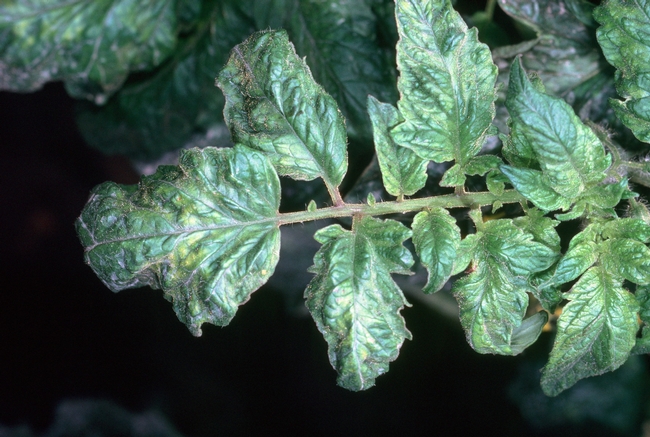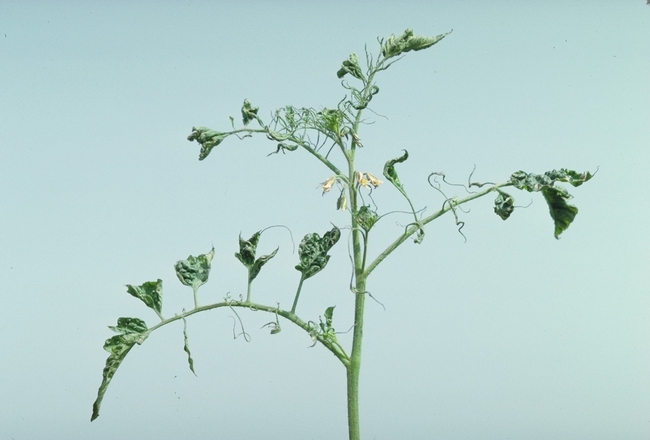Most gardeners are aware of plant diseases that can wreak havoc in their gardens. If you grow fruit trees, you may be confronted with curled, reddened peach leaves (peach leaf curl fungus). If you grow apples or pears, your trees may sometimes look like they were scorched with a blow torch (fire blight bacterium). But did you know that viruses can also lurk in the leaves, stems, and fruit of your garden vegetables and flowers? A virus infection can reduce a plant's growth, lower its yield, and/or result in inferior fruit, vegetables, or flowers.

Viruses attach to cells, penetrate, uncoat, replicate, assemble, and then are released. The time between initial introduction and systemic plant infection varies from a few days to a few weeks. Transmission to other plants completes a virus's life cycle.
History
The first plant virus to be discovered was found on the leaves of tobacco plants in the late 19th century. Researchers found that sap from infected tobacco leaves caused green and yellow mottling (“mosaic”) symptoms in healthy plants. Unlike bacteria, this virus could not be filtered out, but boiling the sap destroyed the infectiousness. Tobacco Mosaic Virus (TMV), the first plant virus discovered, remains one of the most common plant viruses. It attacks not just tobacco but also other members of the nightshade family (Solanaceae), including eggplant, cucumber, pepper, potato, tomato, petunia, snapdragon, delphinium, and marigold.
Virus Transmission
Transfer of virus-infested sap may occur during agricultural practices (through damage caused by tools or hands) or naturally (by an animal feeding on the plant). Plant viruses can also be transmitted by insects, nematodes, fungi, and through pollen, seed, or vegetative propagation from infected parent plants.

There are many, many plant viruses that collectively have the potential to infect virtually all species of plants. Fortunately, host ranges of individual viruses vary from very narrow to very broad. Plants can prevent viral infection through either passive or active defenses. In passive defenses, some plants simply don't produce one or more of the factors required for a particular virus to reproduce and spread within that species. Active defenses detect and destroy or wall off virus-infected cells by the action of resistant genes in the plant.
Virus Symptoms
Viruses typically spread throughout the whole plant and cause a systemic infection. A plant's response to infection can range from completely symptomless to severe disease and plant death, depending on the host and the particular virus.
Typical leaf symptoms of a plant virus include mosaic patterns, chlorotic (yellow) or necrotic (brown) lesions, yellowing, stripes or streaks, vein clearing (becoming translucent), vein banding (where bands of a lighter or darker color occur alongside veins), and leaf rolling and curling. Flower symptoms include deformation and changes in the color and pattern of the flowers. Fruit and vegetable symptoms may include mosaic patterns, stunting, discoloration or malformation, and chlorotic ringspots. Stems may develop stem pitting and grooving or tumors in response to virus infection.
Disease Management
Understanding a virus disease is the first step. Consult the UC IPM website to help identify virus disease possibilities that might infect the plant species of concern. There is no cure for a virus disease once a plant is infected. Prevention or reducing spread between plants is the only possibility. Some viruses are spread by aphids and other insects that suck plant juices so controlling them on vegetables can be helpful.
Herbaceous ornamentals and certain vegetables are generally more susceptible to serious injury or death from viruses, especially when plants are young. Prevention includes using certified virus-free seed or plant material and elimination of virus reservoirs in surrounding vegetation. Grow virus resistant cultivars when available. Provide proper cultural care to improve plant vigor. Management depends on how a virus enters the plant, how it is transmitted between plants, and where it survives when susceptible vegetables are not present. Dig out and destroy virus-infected plants.
Tobacco mosaic virus (TMV) is also known as tomato mosaic virus. It commonly appears at this time of year. TMV infects a plant by entering a break in the cell walls caused by insects or other physical damage. Leaves infected with this virus become mottled with yellow and green spots. The dark green spots often appear thicker and somewhat raised, giving the leaves a blister-like appearance. Mottled areas may turn brown and wither. Plants infected with TMV may be stunted and produce very little fruit.
To manage TMV, remove and destroy any symptomatic plants. Avoid use of tobacco around tomato plants. Use only certified virus-free seed. Sanitation is the single most recommended practice to control TMV, because transmission of the virus from plant to plant usually occurs from contaminated tools or hands. The most common sources of infection are the debris of infected plants that remains in the soil. After removing diseased plants, wash your hands and decontaminate tools. Surface sterilize seeds with bleach before planting. There are no chemical sprays that will prevent, control or eradicate viruses.
Viruses rarely kill woody plants but may alter their appearance with line patterns or ring spots on their leaves. When available, planting certified virus-free stock is the best approach. Rose mosaic virus, is a common example that often has clear visual symptoms in the leaves, especially in cool spring weather. Controlling insects is not an effective method of preventing virus infection in woody ornamentals since low densities of pests can spread viruses throughout the life of perennial shrubs and trees. Virus infected ornamentals should be removed if severe stunting compromises the value of the plant in the landscape. Locally, many very productive almond orchards continue to be hosts of a mild plant virus. There is some debate in the commercial nursery industry as to whether or not this needs to be addressed with certified virus clean stock when trees are propagated for new orchards.
Several other viruses that affect garden plants and vegetables will be discussed in the next Real Dirt column.
The UC Master Gardeners of Butte County are part of the University of California Cooperative Extension (UCCE) system. To learn more about us and our upcoming events, and for help with gardening in our area, visit our website. If you have a gardening question or problem, call the Hotline at (530) 538-7201 or email mgbutte@ucanr.edu.